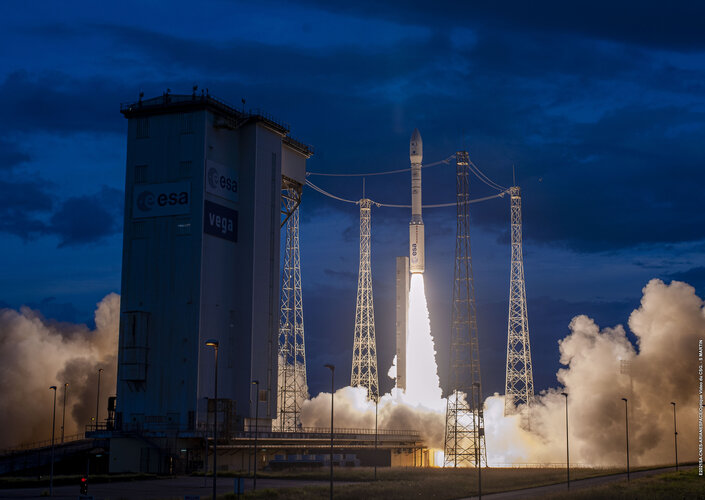
Copernical Team
Monday, 15 November 2021 10:43
ESA uses space to supercharge climate action

ESA is primed to play a crucial role in the revitalised international drive to combat global warming set out at the COP26 climate talks.
Published in
News
Tagged under
Tuesday, 16 November 2021 11:29
Northrop Grumman completes Hypersonic and Ballistic Tracking Space Sensor CDR
Redondo Beach CA (SPX) Nov 12, 2021
 Northrop Grumman recently completed the critical design review of the Hypersonic and Ballistic Tracking Space Sensor (HBTSS) prototype for the U.S. Missile Defense Agency (MDA). The review establishes the company's technical approach for precise, timely sensor coverage to defeat ballistic and hypersonic missiles.
HBTSS satellites will provide continuous tracking and handoff to enable targe
Northrop Grumman recently completed the critical design review of the Hypersonic and Ballistic Tracking Space Sensor (HBTSS) prototype for the U.S. Missile Defense Agency (MDA). The review establishes the company's technical approach for precise, timely sensor coverage to defeat ballistic and hypersonic missiles.
HBTSS satellites will provide continuous tracking and handoff to enable targe
Published in
News
Tagged under
Tuesday, 16 November 2021 11:29
Russia seeks to reassure ISS astronauts after missile claims
Moscow (AFP) Nov 16, 2021
 Russia's space agency said on Tuesday its "main priority" was the safety of the International Space Station's crew, after the US accused Moscow of putting the astronauts under threat with a missile strike.
US officials on Monday denounced Russia for conducting a "dangerous and irresponsible" missile test that blew up one of its own satellites, creating a debris cloud that forced the ISS cr
Russia's space agency said on Tuesday its "main priority" was the safety of the International Space Station's crew, after the US accused Moscow of putting the astronauts under threat with a missile strike.
US officials on Monday denounced Russia for conducting a "dangerous and irresponsible" missile test that blew up one of its own satellites, creating a debris cloud that forced the ISS cr
 Russia's space agency said on Tuesday its "main priority" was the safety of the International Space Station's crew, after the US accused Moscow of putting the astronauts under threat with a missile strike.
US officials on Monday denounced Russia for conducting a "dangerous and irresponsible" missile test that blew up one of its own satellites, creating a debris cloud that forced the ISS cr
Russia's space agency said on Tuesday its "main priority" was the safety of the International Space Station's crew, after the US accused Moscow of putting the astronauts under threat with a missile strike.
US officials on Monday denounced Russia for conducting a "dangerous and irresponsible" missile test that blew up one of its own satellites, creating a debris cloud that forced the ISS cr
Published in
News
Tagged under
Tuesday, 16 November 2021 11:29
Russian military admits 'destroyed' satellite during test
Moscow (AFP) Nov 16, 2021
 Russia's defence ministry on Tuesday admitted to destroying one of its satellites during a missile test, confirming accusations levied earlier by the United States.
"The Russian defence ministry successfully conducted a test, as a result of which the Russian spacecraft 'Tselina-D', which had been in orbit since 1982, was destroyed," the military said in a statement.
US officials on Monda
Russia's defence ministry on Tuesday admitted to destroying one of its satellites during a missile test, confirming accusations levied earlier by the United States.
"The Russian defence ministry successfully conducted a test, as a result of which the Russian spacecraft 'Tselina-D', which had been in orbit since 1982, was destroyed," the military said in a statement.
US officials on Monda
 Russia's defence ministry on Tuesday admitted to destroying one of its satellites during a missile test, confirming accusations levied earlier by the United States.
"The Russian defence ministry successfully conducted a test, as a result of which the Russian spacecraft 'Tselina-D', which had been in orbit since 1982, was destroyed," the military said in a statement.
US officials on Monda
Russia's defence ministry on Tuesday admitted to destroying one of its satellites during a missile test, confirming accusations levied earlier by the United States.
"The Russian defence ministry successfully conducted a test, as a result of which the Russian spacecraft 'Tselina-D', which had been in orbit since 1982, was destroyed," the military said in a statement.
US officials on Monda
Published in
News
Tagged under
Tuesday, 16 November 2021 09:27
Latest Vega launch paves way for Vega-C

Arianespace announced liftoff of Vega’s twentieth flight from Europe’s Spaceport in French Guiana at 9:27 GMT (10:27 CET; 06:27 local time). Vega delivered three CERES payloads for the French Ministry of the Armed Forces.
Published in
News
Tagged under
Tuesday, 16 November 2021 06:15
Astronauts shelter in space capsules as debris comes close to ISS
Washington DC (UPI) Nov 15, 2021
 The seven astronauts working aboard the International Space Station were forced to take shelter in their space capsules as a cloud of debris moved toward the station on Monday.
While the debris eventually moved away from the ISS, NASA's mission control in Houston advised the astronauts to seek refuge to avoid a collision that might require them to return to Earth.
The U.S State D
The seven astronauts working aboard the International Space Station were forced to take shelter in their space capsules as a cloud of debris moved toward the station on Monday.
While the debris eventually moved away from the ISS, NASA's mission control in Houston advised the astronauts to seek refuge to avoid a collision that might require them to return to Earth.
The U.S State D
 The seven astronauts working aboard the International Space Station were forced to take shelter in their space capsules as a cloud of debris moved toward the station on Monday.
While the debris eventually moved away from the ISS, NASA's mission control in Houston advised the astronauts to seek refuge to avoid a collision that might require them to return to Earth.
The U.S State D
The seven astronauts working aboard the International Space Station were forced to take shelter in their space capsules as a cloud of debris moved toward the station on Monday.
While the debris eventually moved away from the ISS, NASA's mission control in Houston advised the astronauts to seek refuge to avoid a collision that might require them to return to Earth.
The U.S State D
Published in
News
Tagged under
Tuesday, 16 November 2021 06:15
Blue Canyon Technologies selected by Ball Aerospace to supply spacecraft bus for NASA Solar Cruiser Program
Lafayette CO (SPX) Nov 16, 2021
 Small satellite manufacturer and mission services provider Blue Canyon Technologies LLC, a wholly-owned subsidiary of Raytheon Technologies Corporation, was selected by Ball Aerospace to develop a standardized X-SAT Venus ESPA-class microsatellite bus and several custom components to enable an upcoming one-of-a-kind mission with NASA for the Solar Cruiser project.
As the largest planned so
Small satellite manufacturer and mission services provider Blue Canyon Technologies LLC, a wholly-owned subsidiary of Raytheon Technologies Corporation, was selected by Ball Aerospace to develop a standardized X-SAT Venus ESPA-class microsatellite bus and several custom components to enable an upcoming one-of-a-kind mission with NASA for the Solar Cruiser project.
As the largest planned so
 Small satellite manufacturer and mission services provider Blue Canyon Technologies LLC, a wholly-owned subsidiary of Raytheon Technologies Corporation, was selected by Ball Aerospace to develop a standardized X-SAT Venus ESPA-class microsatellite bus and several custom components to enable an upcoming one-of-a-kind mission with NASA for the Solar Cruiser project.
As the largest planned so
Small satellite manufacturer and mission services provider Blue Canyon Technologies LLC, a wholly-owned subsidiary of Raytheon Technologies Corporation, was selected by Ball Aerospace to develop a standardized X-SAT Venus ESPA-class microsatellite bus and several custom components to enable an upcoming one-of-a-kind mission with NASA for the Solar Cruiser project.
As the largest planned so
Published in
News
Tagged under
Tuesday, 16 November 2021 06:15
The first black hole image: A gravitomagnetic monopole as an alternative explanation
Washington DC (SPX) Nov 16, 2021
 The Event Horizon Telescope (EHT) has recently mapped the central compact object of the galaxy M87 with an unprecedented angular resolution. Though the remarkable breakthrough has been interpreted based on theory that M87 contains a rotating or "Kerr" black hole.
New research published in EPJ C by Chandrachur Chakraborty and Qingjuan Yu at the Kavli Institute for Astronomy and Astrophysics
The Event Horizon Telescope (EHT) has recently mapped the central compact object of the galaxy M87 with an unprecedented angular resolution. Though the remarkable breakthrough has been interpreted based on theory that M87 contains a rotating or "Kerr" black hole.
New research published in EPJ C by Chandrachur Chakraborty and Qingjuan Yu at the Kavli Institute for Astronomy and Astrophysics
 The Event Horizon Telescope (EHT) has recently mapped the central compact object of the galaxy M87 with an unprecedented angular resolution. Though the remarkable breakthrough has been interpreted based on theory that M87 contains a rotating or "Kerr" black hole.
New research published in EPJ C by Chandrachur Chakraborty and Qingjuan Yu at the Kavli Institute for Astronomy and Astrophysics
The Event Horizon Telescope (EHT) has recently mapped the central compact object of the galaxy M87 with an unprecedented angular resolution. Though the remarkable breakthrough has been interpreted based on theory that M87 contains a rotating or "Kerr" black hole.
New research published in EPJ C by Chandrachur Chakraborty and Qingjuan Yu at the Kavli Institute for Astronomy and Astrophysics
Published in
News
Tagged under
Tuesday, 16 November 2021 06:15
NASA Administrator Statement on Russian ASAT Test
Washington DC (SPX) Nov 15, 2021
 On Monday Moscow Standard Time, the International Space Station (ISS) Flight Control team was notified of indications of a satellite breakup that may create sufficient debris to pose a conjunction threat to the station. NASA Administrator Bill Nelson released the following statement about the incident:
"Earlier today, due to the debris generated by the destructive Russian Anti-Satellite (A
On Monday Moscow Standard Time, the International Space Station (ISS) Flight Control team was notified of indications of a satellite breakup that may create sufficient debris to pose a conjunction threat to the station. NASA Administrator Bill Nelson released the following statement about the incident:
"Earlier today, due to the debris generated by the destructive Russian Anti-Satellite (A
 On Monday Moscow Standard Time, the International Space Station (ISS) Flight Control team was notified of indications of a satellite breakup that may create sufficient debris to pose a conjunction threat to the station. NASA Administrator Bill Nelson released the following statement about the incident:
"Earlier today, due to the debris generated by the destructive Russian Anti-Satellite (A
On Monday Moscow Standard Time, the International Space Station (ISS) Flight Control team was notified of indications of a satellite breakup that may create sufficient debris to pose a conjunction threat to the station. NASA Administrator Bill Nelson released the following statement about the incident:
"Earlier today, due to the debris generated by the destructive Russian Anti-Satellite (A
Published in
News
Tagged under
Tuesday, 16 November 2021 06:15
LeoLabs Australia's Space Tracking Centre releases first images of Russian space debris field
Washington DC (SPX) Nov 16, 2021
 As reported, the Russian Federation tested a probable 'Nudol' direct ascent anti-satellite missile yesterday at 150250Z from Pllesetk, Russia with the target a defunct Russian satellite called Cosmos 1408. The US Space Command has reported there is a large debris cloud of up to 1000 pieces forming around Cosmos 1408's area of orbit.
LeoLabs Australia Managing Director and former Air Commod
As reported, the Russian Federation tested a probable 'Nudol' direct ascent anti-satellite missile yesterday at 150250Z from Pllesetk, Russia with the target a defunct Russian satellite called Cosmos 1408. The US Space Command has reported there is a large debris cloud of up to 1000 pieces forming around Cosmos 1408's area of orbit.
LeoLabs Australia Managing Director and former Air Commod
Published in
News
Tagged under
